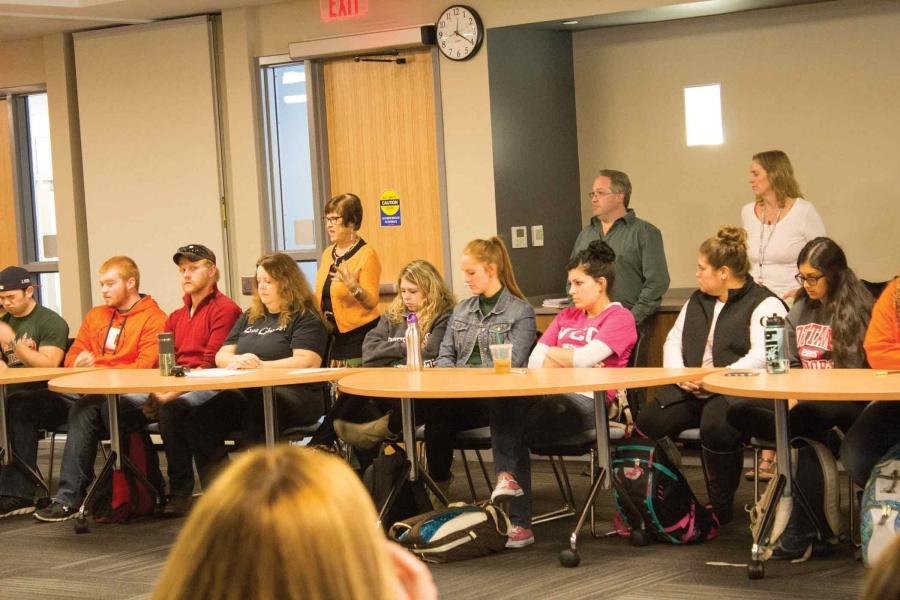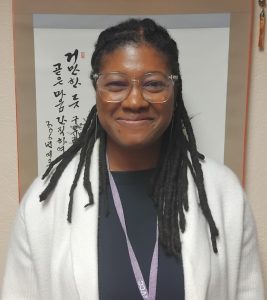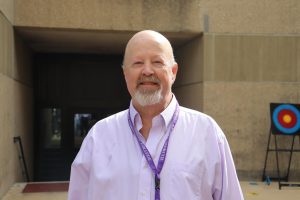Recent mass shootings spark round-table discussion
Instructor Jean Batson-Turner discusses gun violence and its relationship to domestic violence at the Oct. 26 round table discussion.
November 16, 2015
IVCC focused on gun violence in America for its second round table discussion. The discussion, moderated by Amanda Cook-Fesperman, IVCC’s Coordinator of International and Multicultural Education, was partly sparked by the recent mass shooting in Roseburg, Ore.
On Oct. 1, a gunman opened fire at Umqua Community College, leaving nine dead and seven injured. The mass shooting in the rural community college was the 45th school shooting in the United States this year, according to www.everytownresearch.org.
“The immediate reaction was to the Oregon shooting, especially because it was a rural community college, not unlike our own. It was another opportunity for a discussion to occur in our country,” said Cook-Fesperman.
Going into the event, Cook-Fesperman did have some reservations, as small details were being questioned in order to keep sensitivity to the Oregon shooting.
“The flyer became a source of debate,” stated Cook-Fesperman, discussing the simple cartoon gun printed over the American flag. The intention was to keep IVCC students feeling safe and comfortable in the building. Which group could fund the event was also a question. Discussions on social topics, such as the Black Lives Matter event, are usually organized by IVCC’s Diversity Team. Due to the sensitive nature of gun violence, Cook-Fesperman decided not to have the discussion use Diversity’s funds or name.
The Roundtable Discussion
The two large meeting rooms were filled with students, showing up to discuss their views on gun violence, while also taking care of the extra credit opportunities offered for attendance.
Cook-Fesperman introduced the discussion by explaining American society’s need to have calm, reasonable dialogue.
“This is not a conversation about gun control; it’s a discussion about gun violence. I think that it’s important that we say that because I think we all can agree we have a problem with gun violence,” stated Cook-Fesperman.
The first question, focusing on why there is gun violence in America, was met with several ideas. The first was the Constitution’s Second Amendment.
“You have the right to bear arms. So it’s telling someone they have the right to own a gun. They think they have that freedom, they can use that right. It’s not stopping the criminals,” stated Jacob Barringer.
Students and faculty also discussed the effects of social media and violent video games. The idea of mass shootings stemming from violent video games has been circulating since the Columbine massacre in 1999, which left 13 dead at the Colorado high school.
The New York Times reported in 2007 that the two Columbine shooters attacked their classmates and teachers shortly after losing their video game privileges, leading some to believe that’s a cause for mass shootings.
Mental Health
An important point in the discussion was the connection that mental health had on American’s issue with gun violence.
“There’s an obvious mental health issue in this country. I think a lot of that comes from the fact that mental illnesses are not getting taken care of,” stated one student.
There has been an ongoing dialogue connecting mental health and mass shootings since the Virginia Tech shooting in 2007. The incident that left 32 dead and 30 more injured is said to be the largest mass shooting in United States’ history, according to the Washington Post.
In 2009 the medical records of Seung Hui Cho, the Virginia Tech shooter, were released, and showed an extreme lack of adequate mental health treatment. Cho attempted to get psychiatric help on three occasions, but was discharged from the hospital after being given a sedative for anxiety and marked with a mood disorder, with no follow up appointment in place. Over a year later, he carried out the massacre at his school and committed suicide. Such a failing mental health system causes people to question the correlation between the mental illness and violence.
Responsible Gun Owners
The idea of accessibility of firearms was also a prominent point in this discussion. “There’s not a lot of limitations to not being able to get a gun.
Who’s to say that doesn’t eliminate a violent person?” stated student Gabriella Rodriguez. The idea of accessibility then shifted the discussion toward an attempt to find a solution for the flawed system of purchasing firearms. Students and faculty then led to discussed what they believe makes a “responsible” gun owner.
“There’s a lot of people who don’t know how to be safe with a firearm. There’s so many ways to learn about it. Make it inaccessible to anyone who could misuse or could harm someone,” stated Barringer.
When asked if the gun owner should be held accountable for any crimes committed resulting from an easily accessible gun, most students agreed the gun owner should be to blame.
“Look at the Sandy Hook and Oregon cases, where it was the mother who had all the guns, and this son who she knew was mentally unstable. If it’s not in the house it’s not accessible,” stated Christina Elricki, referring to the massacre at Sandy Hook Elementary School, which resulted in the deaths of 20 children and six faculty members.
Responsible gun owner advocates then retorted. “It’s not necessarily a case that the guns in the house are the problem. She’s an irresponsible gun owner and she allowed her mentally unstable son to have access to the weapons, which were loaded,” said Jake Quesse.
The idea of being a responsible gun owner allowed the discussion to pave the way toward Professor Jared
Olesen’s idea of an insurance for firearm owners. The notion of insurance focused on a protection toward firearm owners, in case their weapons are used in associated with a crime. Basically, one would register the firearm’s serial number and pay a certain rate to insure their safety in the event that someone is harmed, much like with car insurance.
While some participants accepted the idea of insurance, some questioned the legal loopholes people could go through.
“Different states have different laws,” stated PTK President Brandon Miller.
It’s the idea of controlling gun violence on a federal level that is troubling in a nation that desperately holds on to a basis of independence and freedom. It is especially difficult with the large amount of guns in circulation, as BBC.com expects there to be 300 million firearms in the United States alone.
In the last few minutes of the discussion, Cook-Fesperman asked several questions to conclude. When questioned if students would feel safe at IVCC, if it were to allow concealed carry weapons, the entire room followed with several no’s, with some mentioning they would leave.
Professor Jeff Fesperman offered the statistic that “persons who are registered to carry concealed weapons are 4.5 times more likely to get into violent altercations.”
Out of the entire crowd, there was nobody who believed that there should be zero regulations on gun laws or the selling of firearms. There was one who believed nobody should be able to carry guns, including the police.
“I really do think that there is common ground on so many issues and this is just one. What’s the next step? What can and should you be doing at a national level?” questioned Cook-Fesperman in her concluding speech, encouraging students to continue this debate by contacting members of Congress.




